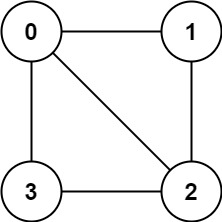There is an undirected graph with n nodes, where each node is numbered between 0 and n - 1. You are given a 2D array graph, where graph[u] is an array of nodes that node u is adjacent to. More formally, for each v in graph[u], there is an undirected edge between node u and node v. The graph has the following properties:
- There are no self-edges (
graph[u]does not containu). - There are no parallel edges (
graph[u]does not contain duplicate values). - If
vis ingraph[u], thenuis ingraph[v](the graph is undirected). - The graph may not be connected, meaning there may be two nodes
uandvsuch that there is no path between them.
A graph is bipartite if the nodes can be partitioned into two independent sets A and B such that every edge in the graph connects a node in set A and a node in set B.
Return true if and only if it is bipartite.
Example

Input: graph = [[1,2,3],[0,2],[0,1,3],[0,2]]
Output: false
Explanation: There is no way to partition the nodes into two independent sets such that every edge connects a node in one and a node in the other.
Solution
Good solution found here
/**
* @param {number[][]} graph
* @return {boolean}
*/
var isBipartite = function (graph) {
//Set up a color array
let colorArr = new Array(graph.length).fill(-1);
colorArr[0] = 1;
let queue = [];
//FOR the length of the graph
for (let i = 0; i < graph.length; i++) {
//IF the graph at i has a length
if (graph[i].length > 0) {
//Push i to the queue
queue.push(i);
}
}
//WHILE the queue has a length
while (queue.length) {
let top = queue.shift();
let neighbors = graph[top];
//FOR the length of the neighbors
for (let node of neighbors) {
//IF the colorArr at node is -1
if (colorArr[node] === -1) {
//Set the colorArr at node to 1 - colorArr at top
colorArr[node] = 1 - colorArr[top];
//Push node to the queue
queue.push(node);
}
//ELSE IF the colorArr at node is equal to the colorArr at top
else if (colorArr[node] === colorArr[top]) {
return false;
}
}
}
return true;
};